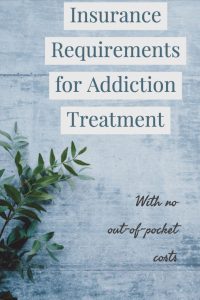Insurance Paying for Rehab – Blue Cross Blue Shield, Aetna, Cigna or United HealthCare
It might sound crazy, but it’s possible to get up to 100% of the cost covered.
Can you relate to this?
After years of substance abuse, you or your loved one is ready to go to treatment. It’s a huge relief. You see an ad for a substance abuse treatment center and it says “Up to 100% of the cost of substance abuse treatment may be covered by your Blue Cross Blue Shield PPO insurance”
You are thrilled.
Insurance Requirements for No Cost Drug Treatment

In most cases, in order for 100% of treatment to be paid for by your insurance carrier (specifically if its Blue Cross Blue Shield, Aetna, Cigna or United Healthcare) you need to meet some requirements. This means you have already paid your entire deductible and your coinsurance out of pocket maximum for the year.
If you are a person seeking addiction treatment for the second time (in the same calendar year) you have probably already met that condition. However, if you or your loved one is seeking drug or alcohol treatment for the first time (in a calendar year) you are going to have to work through some obstacles.
The important thing — don’t get discouraged. If there is a will there is away.
Insurance Paying for Rehab for First Time Addiction Treatment
For those of you who are going into substance abuse treatment for the first time this year, I will explain how to calculate your cost. This is for inpatient substance abuse treatment and the total is what portion of your treatment, the insurance will pay. Since this is your first time to treat addiction this calendar year most likely you will need a scholarship or financial assistance.
This is to have up to 100% of the cost of treatment be covered by Blue Cross Blue Shield, Aetna, Cigna or United Healthcare insurance policies.
There are three major items that make up the majority of what treatment is going to cost they are your:
- Unmet Deductible
- Coinsurance
- Out-of-Pocket Maximum
Most everyone knows what their insurance deductible is and how they work. The deductible is usually easy to find on your insurance policy, insurance card or summary of benefits.
Deductibles typically range between $1,000 and $7,500 on most employer-based insurance plans. The unmet deductible is the dollar amount still owed against your deductible.
For this example let’s say you have a $2,500 deductible and prior to seeking treatment you had paid $500 for a medical test. Therefore your unmet deductible is $2,000. This $2,000 number is the first of three important numbers in calculating how much money you may need to pay for drug or alcohol treatment.
Coinsurance Costs for Addiction Treatment
When it comes to inpatient substance abuse treatment your deductible may be only a small portion of your cost of treatment. Coinsurance is the next factor to consider when figuring out how much treatment will cost.
I am not talking about the $10-$50 copays you are used to paying for prescriptions and or doctor office visits. Coinsurance generally kicks in on serious situations like surgery and hospitalization or in this case it kicks in when you need inpatient substance abuse treatment.

A typical Blue Cross Blue Shield, Aetna, Cigna or United Healthcare employer issued insurance policy (after the deductible is paid) pays between 60% – 90% of the inpatient treatment and or hospitalization cost. The remaining 10% – 40% of the inpatient treatment and or hospitalization cost is called coinsurance and you are responsible to pay for that coinsurance percentage (usually 10%-40%).
I know this sounds complicated but with the help of a treatment placement specialist, you will get a quick walkthrough. This process can happen quickly and professionally. A specialist will also verify your insurance benefits to find out your exact cost.
Addiction Insurance and Out-of-Pocket-Maximum
The good news is there is a thing called “out-of-pocket maximum” which typically ranges from $5,000 to $25,000 on employer-provided insurance plans. This dollar amount is the most you are responsible to pay for on all covered services in any plan year. For purposes of this example let’s use $15,000 as the out of pocket maximum or “OOP max” as insurers call it.
Insurance Caveat
Before we tally up the cost of treatment based on what I just explained I have one more caveat that some insurance policies include the deductible in the OOP Max and others don’t.
EXAMPLE A.
- 90 Day treatment cost $60,000
- Unmet Deductible $2,000
- Coinsurance 40% or $24,000
- Out of pocket maximum $15,000
In the above example, you would be responsible for either $15,000 or $17,000 for the cost of treatment depending on whether or not your policy considers the deductible as part of the out of pocket max or not.
In summary, the key components in calculating the costs of treatment are how much is your unmet deductible and how much is you’re out of pocket maximum.
- Cost of treatment
- Unmet deductible
- Out of pocket maximum
- Does deductible apply to you out of pocket maximum?
Don’t give up if the amount needed is overwhelming and or appears to be an amount you cannot afford this is where things like scholarships and financial assistance that can help pay for the costs of treatment.
Do you have a question for the author? Simply type it in our chat bar and he will get back to you within 24-hours.
About the Author
Bruce Berman personally has assisted several hundred people into treatment for alcohol, substance abuse, and dual diagnosis. He has maintained continuous recovery from various addictions since September 1989. Besides himself, he has placed his own children, employees, family members, friends and other loved ones into various treatment programs. Whether you are struggling with addiction or a loved one is most likely the author has dealt with a similar situation in the past. Bruce is a father of four children ages 9 to 31 and happily married to his wife Victoria who has also been in recovery since November 1995. Together Bruce and Victoria run 800 Recovery Hub a company that specializes in placing people in need of treatment into the best treatment center they can.
DISCLOSURE
Bruce Berman is not a medical doctor, holds no degrees or licensees in addiction and has no formal education in treating addiction. He relies solely on his personal experience gained in attending and participating in over 10,000 hours in various 12 step meetings since 1989 as well as the experience he has working with addicts and their families since 1989.